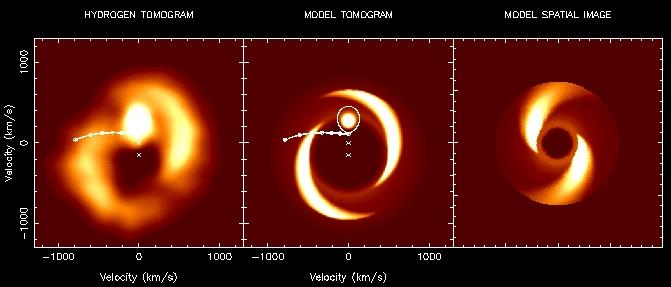Credit & Copyright: D. Steeghs, E. Harlaftis, K. Horne,
Astronomy Group, Univ. St.Andrews
Explanation:
Spiral arms aren't
just for galaxies.
A hot disk of gas surrounding a compact
white dwarf star
in the constellation of Pegasus
has recently been revealed
to be imprinted with this dramatic pattern.
The white dwarf is part of the interacting
binary star system
IP Pegasi and the disk of gas is an accretion disk formed of
material lost from a companion star and falling toward the
white dwarf.
The disk itself is smaller than the Sun's diameter, so
the spiral pattern can not be
imaged directly by telescopes.
Instead, the spiraling disk of gas is mapped over a
series of observations using a
spectroscopic technique known as
doppler tomography.
The left panel above shows a tomogram, the directly
measured gas velocity map for
the system. The relative brightness corresponds to the intensity
of light emitted by Hydrogen gas moving at the indicated velocity.
The position at the center of this panel represents the velocity of
the binary system's center of mass.
In the middle panel, a simple
model velocity field consistent with the measurements is shown.
At the right, the calculated position map of the
IP Pegasi accretion disk
reveals a striking two armed trailing spiral pattern.
1999 2000 2001 2002 2003 2004 2005 2006 2007 2008 2009 2010 2011 2012 2013 2014 2015 2016 2017 2018 2019 2020 2021 2022 2023 2024 2025 |
Yanvar' Fevral' Mart Aprel' Mai Iyun' Iyul' Avgust Sentyabr' Oktyabr' Noyabr' Dekabr' |
NASA Web Site Statements, Warnings, and Disclaimers
NASA Official: Jay Norris. Specific rights apply.
A service of: LHEA at NASA / GSFC
& Michigan Tech. U.
|
Publikacii s klyuchevymi slovami:
belyi karlik - akkrecionnyi disk - dvoinye zvezdy - effekt Dopplera
Publikacii so slovami: belyi karlik - akkrecionnyi disk - dvoinye zvezdy - effekt Dopplera | |
Sm. takzhe:
Vse publikacii na tu zhe temu >> | |
